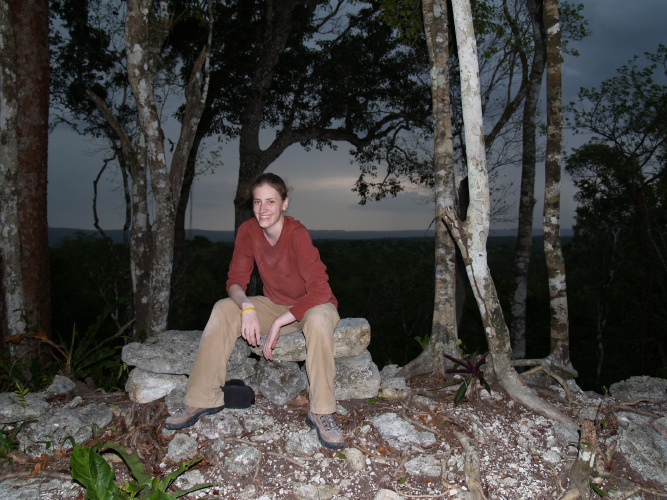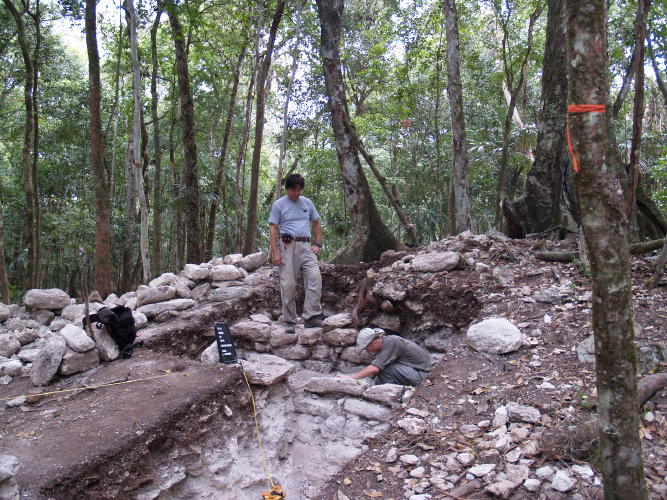by Brianna Rego
Although I was born in Guatemala, I moved to Idaho when I was 5. My early-childhood memories are filled with larger than life books of Maya pyramids, dog-eared copies of Incidents of Travel in Yucatán, and parental controlled expeditions with my brothers through the vines and jungles surrounding Tikal. In 2005 I was a history major at Oberlin College with a minor in Geology and my postgraduate plans involved a Ph.D. in the history of science. Francisco Estrada-Belli (then Assistant Professor at Vanderbilt University and now Associate Professor at Boston University) accepted me to briefly participate in his excavation of the Maya site of Holmul that would be researching an epoch of roughly 1500 years ago. I decided to write my undergraduate honors project on bioarchaeology and geoarchaeology, conduct research work at Holmul, and use my other research hours to read about the Ancient Maya. Although not initially trained in field archaeology, I kept a journal and offer here a first-person narrative of my first archaeological experience. Holmul is an Early Classic Maya site about sixty kilometers west of the Belize border in the northern jungle lowlands of Guatemala, an area known as the Petén region. The Maya Early Classic period is from 300-550 AD.
My first adventure started early, as I got to the airport in Guatemala City at 5:30 am and stood in front of the Tikal Jets counter waiting for my regional flight to the Petén. After a few minutes of no activity, I pondered my collection of luggage. Realizing my choice was between carrying my bags and finding answers or not carrying my bags and missing my flight, I hauled my backpack on, slung my tent across my back, picked up my two duffels and waddled over to the information desk. When I asked for Tikal Jets to Flores, Petén, the man gave me a horrified look, said something about “ay ay ay, corre,” and took off running across the airport. As it happens, Tikal Jets doesn’t leave from the airport, like every other airline, but rather from a distant hangar a taxi ride away. I was promptly packed into a taxi that took off, wheels squealing, with one of my legs still hanging out the door. The cab screeched to a halt in front of the distant hangar just in time for me to be told that, due to “meteorological reports,” my flight had been delayed, and they appreciated our “comprehension of the subject.” By the time I had maneuvered all my bags through the doors it was announced that the “airport was once again open for traffic,” and we all trooped onboard a plane that seemed unnecessarily large for the paltry amount of passengers and the 30-minute flight.
Upon arriving at the airport in Flores, there was a large sign welcoming me to “El Mundo Maya.” I knew my adventure was about to begin, but couldn’t help noticing the odd looks I was getting from fellow passengers disembarking the plane. It wasn’t until I collected my baggage that I understood why: while everybody else was prancing around in fashionable attire (there were actually people daintily awaiting their day in the jungle in stilettos and clutch purses), I was clomping around in boots and hauling tents. No matter, thought I, and I went to find the driver Francisco had arranged for the 2-hour drive to Melchor de Mencos’right on the Belize border’where Francisco would be meeting me.
We took off the next day for Holmul, dropping off and picking up laundry and water on our way out. It is normally a 2-hour drive to the camp from Melchor, but the day before it had taken Francisco 3 1/2 hours because he had to stop and clear the road of trees and vines (they carry a chainsaw in the back of the truck). There had been a hurricane-force apple-sized-hail storm, he told me. Welcome to the tropics! I thought… The 60-kilometer “road” to Francisco’s camp is literally cut right into the jungle. It is barely wide enough for a car to pass, and even so, vines hit the windshield and monkeys jump out of the way. Our speed of fifteen miles per hour seemed frighteningly fast through the trees. The road was so rutted and muddy that it seemed paved with speed bumps.
Our arrival at camp coincided with the end of the workday, so I was able to meet everybody and get a tour of the camp before dinner. The team was made up of Francisco, his wife Nina (a graduate student at Tulane), 5 other graduate students (everywhere from Harvard to Vanderbilt to University of California), 8 undergraduates from Vanderbilt who were participating in a month-long field school, about 30 Guatemalan workers, and a couple of cooks. The camp itself is constructed of open-air thatched roofs and boasts a lab, a mess/dining area, kitchen, four toilets and four showers. Tents are scattered along the road. The night before I got there, the big storm had knocked over several trees, smashing completely one of the tents, so I was a bit wary of the vegetation looming over me as I started getting settled.
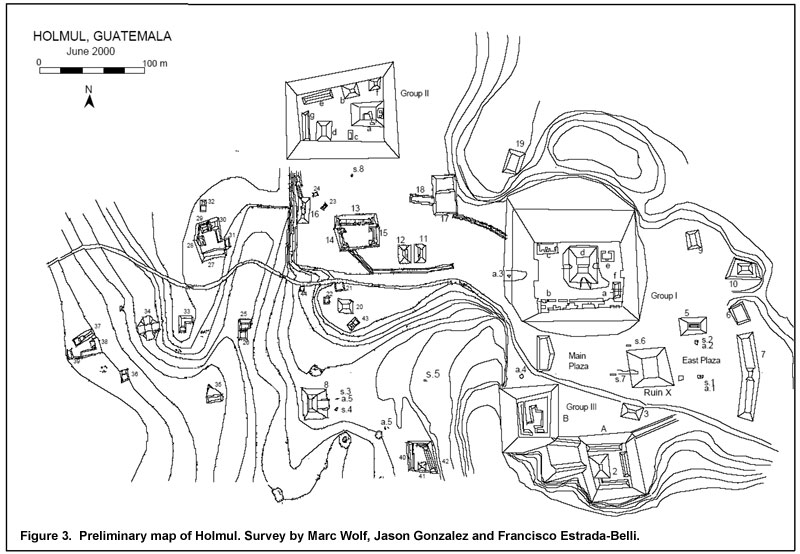
The year before (2004), one of Francisco’s capable graduate students, Jennifer Foley, a Ph.D. student at Vanderbilt, made a very significant Maya discovery: she found a wall of mural hieroglyphs in a buried room of Structure 1 at a part of the Holmul site called La Sufricaya. They uncovered enough of the murals to see a date – 16 Mak 11 Eb in the Maya calendar (early January 378 AD), but that was all that could be done before the end of the season and without a staff photographer on site. The date they found, though, made everybody excited for 2005 when the murals could be excavated and archaeologists could finally see what else was written. The date is probably one of the most important dates in Maya history, when a visitor from Teotihuacan (southern modern-day Mexico City) named Sihyah K’ahk’ arrived at the great Maya city of Tikal, also in the Petén region of Guatemala. Finding this date at Holmul was significant because nobody knows exactly what happened when this visitor arrived at Tikal (also recorded at Tikal on Stela 31), only that he arrived there (and that the local ruler mysteriously died on that day and the Lowlands were subsequently flooded with Teotihuacan-style buildings and objects). The Holmul murals therefore could possibly fill in the missing history, depending on what they said and in what kind of condition they were in. What is more, Francisco explained to me, if the murals did illuminate the events at Tikal it would establish Holmul as an important city of that time and help connect it to the rest of the Maya world as a big center and not just as “another city”, resolving the controversy over the relative importance of Holmul.
In order to reveal the murals, Francisco had arranged for a noted Italian art conservator, Alberto Semeraro, who had also worked at Holmul in 2003 and beyond, to fly in for a few days to excavate and prepare them for an artist who would be arriving at Holmul the following week. Alberto, however, had been held up by passport problems and wasn’t going to be able to make it in time, leaving Francisco’and the murals’in a temporary bad spot. All of this was happening the day Francisco picked me up in Melchor, so he was brainstorming on how to resolve the situation on our drive to Holmul. He came up with what to him seemed obvious: he would improvise and use me to help. Francisco himself would excavate the murals, and I would photograph them.
My first full day on the dig, I woke early and packed my lunch of rice and beans. At 7:00 am I climbed into Francisco’s newest toy, a 4-wheeler Yamaha ATV christened the “Maya Baby Hunter” (last year’s toy, a big Yamaha truck, is called the Maya Hunter). Francisco has a sick sense of humor. He fastened his seat belt, gave me a grin, and took off charging through the jungle at 8 mph, a shockingly sprightly speed through the trees. The three workmen clinging to the back shouted “Cuidado!” (“Careful!”) every time a vine swung too close. We arrived at our designated spot’which looked to me just like the rest of the jungle’got out, and started navigating through the trees, no clear destination in sight. It didn’t take long before countless unexcavated Maya structures started appearing on all sides of us, some small, some larger than life, all mounds of turf with trees growing out of the ancient rock at odd angles.
Our site was Structure 1 at the top of a pyramid mound and the only way to get to it was up a rickety log ladder hammered into the side. No tourist accommodations here, this was the real deal. We got to the top and our workmen started clearing out what Francisco had back-filled the year before. While they did this, Francisco and I set off running through the jungle in search of the howler monkeys we could hear. Ah, the joys of archaeology! Oh, but the joys are short lived, as it wasn’t long before the workmen were removing original Maya fill and I was handed a trowel and set to work.
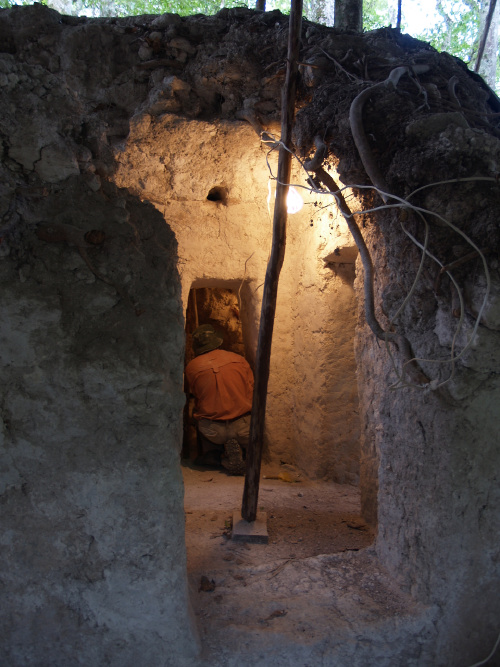
The mural room (Mural 6-North) in which we were working was an inner room of the larger Structure 1. The reason we were removing so much original Maya fill is that, when the Maya built a structure, after some time the structure would begin to fall apart because, as I learned only too well, the jungle is a harsh environment. So, the Maya would fill in all the rooms with stones, throwing in trash of broken pottery and chert to fill in the cracks, and then they would build another structure on top. Francisco is interested in the early Maya, therefore most of his excavations are of these earlier phases of structures. My job was to sift bucketful after bucketful of everything that wasn’t stone, so I sifted dirt… a lot of dirt. I was in search of artifacts and I was amazed by how exciting it was every time I found a pottery sherd and realized I was the first person to touch it in about 1500 years. The first thing I found was a gray-green translucent obsidian blade that the Maya would have used for body piercing. It looked terribly painful and intimidating to me, but Francisco was super excited and called me a “natural.” I just think it was beginner’s luck, but it made me realize that there I was, one of only 5 people at the top of that Maya structure in the middle of the jungle. It was a hundred degrees and 3000% humidity, and I was “playing” with dirt and obsidian all day long.
The second day started much like the first, and Francisco and I once again set off bumping our way through the jungle in the Maya Baby Hunter. As we were driving away from camp, Francisco gave me an olfactory tour of the jungle. He stopped the Baby Hunter every hundred feet or so to “smell the jungle.” When you pay attention like that, it really is amazing how no two spots smell alike. We concluded that, while one spot smelled like ripened vineyards, another smelled like monkey poop, and still another like honey. The previous day’s endless sifting had faded from my mind and I gazed around the jungle. There was more fill to remove, but Francisco wandered over to an as-yet unexplored area of the structure. He handed me a trowel, and told me to dig. So we dug. I manned the trowel while Francisco took control of the machete. I shoveled dirt aside and he whacked away at invading roots. By the end of the day we had uncovered a staircase leading up to a wall. A new Maya mystery, and one for the next year…
After working with a pickax for much of a day at a nearby context, the next day I woke up with stiff arms and sore muscles although I’ve been athletic my whole life. But there was much to be done as Francisco was ready to go again. That morning Francisco decided to show me something that he called “The Vault.” He ventured off, leaping through the ruins, and I crashed along after him. An ominous label, The Vault was disturbingly reminiscent of a misadventure from Indiana Jones. The Vault is an underground tunnel connecting two underground rooms and as I descended the rotting ladder I found myself in an endless black pit. Francisco, shining his light on the cold stone floor of the tunnel, announced that there were no snakes. I landed with a “plop” and looked around. All around me, hanging upside down from cobwebs were countless bats. We started shuffling our way along the winding tunnel when suddenly Francisco shouted at me to cover my face, duck, and run‘through the ancient underground vault’as close to a hundred bats flapped down on us from all sides. After our underground adventure, we went back up to sunlight and to the top of our structure. Francisco was ready to excavate the murals, but I was just glad to be away from the bats.
We started the generator, threaded the orange-yellow lights through the cramped doorway, and lit up the room with the murals. Today was the day we would uncover the rest of the hieroglyphs and I was ready to photograph their excavation. I stood over Francisco’s shoulder taking pictures and handed him tools as he carefully requested them like a surgeon. He handed back shards of plaster and I scanned them for bits of paint. We stayed really late. It was dark when we left, but we wanted to finish. At the end of the day, Francisco and I were the first two people to see parts of those murals since they had been covered up by the Ancient Maya, more than a millennium and a half ago. I was one of the first persons ever to photograph them, and my pictures are the only ones documenting their initial excavation. Realizing all this, as I stood looking at these murals, made me forget the dark. Francisco’s wife Nina, though, remembered the dark all too well and by the time we rolled into camp that night, two hours later, she was about to organize a search party. That night all the archaeologists spent the remaining hours before bed studying my pictures and trying to decipher the glyphs. I felt proud that I had contributed something, even though I was no more than a beginner in archaeology. This brief time at Holmul and the challenges faced there would fuel other research in my quest into the history of science.
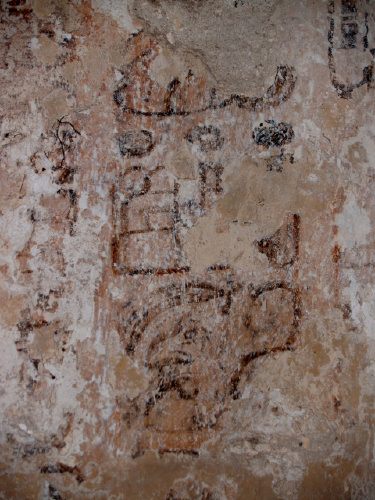
As I learned a few years later, the text turned out to be a dedication of the building itself, made one year after the arrival of Sihyah K’ahk’ at Tikal. The date at Tikal and the date at Holmul are exactly 364 days apart, as if the building at Holmul were to commemorate that anniversary. The inscription proved finally that the arrival event was a true turning point in the history of Tikal and Holmul alike, as Francisco and his students had suspected. The fact that Sihyah K’ahk’ was mentioned showed that Tikal’using Teotihuacan as ally’went on to establish alliances at places like Holmul, quickly forming an empire in the Lowlands.
